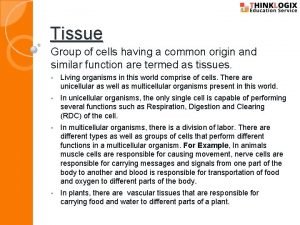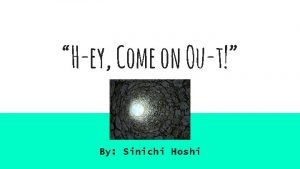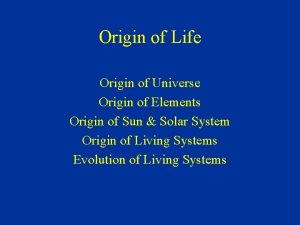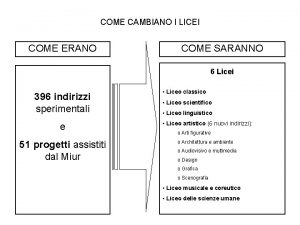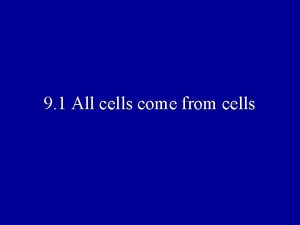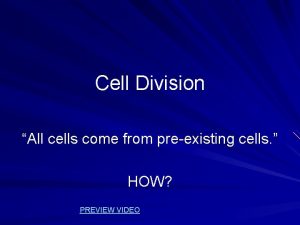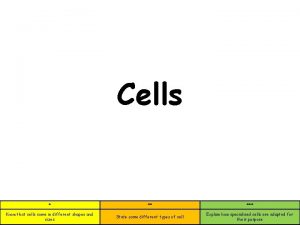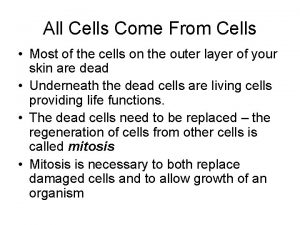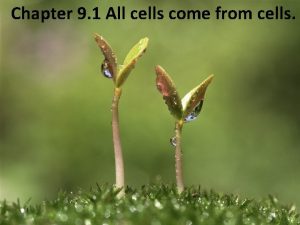1 5 The Origin of Cells Cells come














































- Slides: 46

1. 5 The Origin of Cells • • Cells come from pre-existing cells The first cells arose from non-living materials • Endosymbiosis

Cell Division & The Origin of Cells All cells are formed by the division of pre-existing cells. You are made of trillions of cells. Any cell that is produced by your body is the product of cell division from another cell. You originally started life as a single cell, a zygote, that underwent numerous cell divisions to produce the trillions of cells that comprise you today.

Even that single celled zygote came from other cells – the combination your father’s sperm cell and your mother’s egg cell. We can trace the origins of all the cells in our parents back to the zygotes from which they developed, to our human ancestors before them, to human’s preexisting ancestral species, all the way back to the earliest cells on Earth.

We, and all other living things on this planet, are descendants from the “first cell”. But if all cells come from pre-existing cells, where did the first cell come from? How did life start on this planet?

Problems for starting life on Earth • How could the lifeless ball of rock that the planet Earth was 3. 5 billion years ago, become home to such lush vegetation and a wide variety of bacteria, fungi, protists, and animals that we see today? • There are 4 problems which needed to be overcome for life on Earth to exist.

Requirements to start life 1. Production of Simple Organic Compounds 2. The assembly of organic compounds into polymers 3. Development of a mechanism for inheritance. 4. Formation of membranes

1. Production of Simple Organic Compounds • Life as we know it is based on organic compounds (compounds containing carbon and hydrogen), such as amino acids (the building blocks of proteins) • But early Earth only had inorganic matter: rocks, minerals, gases, water….

• Abiogenesis had to occur. • abiogenesis: the creation of organic matter from inorganic matter) • It is believed that organic molecules were formed in the shallow waters of the oceans as the products of chemical reactions between compounds in the atmosphere and the water.

Miller and Urey Scientists Stanley Miller and Harold Urey performed a groundbreaking experiment in 1953 They recreated the conditions of early Earth and proved that organic compounds could be synthesized from inorganic compounds.

N 2 = nitrogen gas H 2 = hydrogen gas CO 2 = carbon dioxide gas H 2 O = water NH 3 = ammonia gas * CH 4 = methane gas

The Experimental Design • The apparatus included an “oceanic compartment” and an “atmospheric compartment” • The H 2 O in the oceanic compartment was heated to evaporate and cooled to condense – thereby recreating the H 2 O cycle. • Since early Earth did not have an ozone layer, they kept the system at a warm temperature and exposed it to UV radiation • Generated electric sparks to simulate lightning


The Results • After 1 week: • 15% of the carbon was now found in organic form! • 13 of the 20 amino acids had formed inside the primordial soup! • Sugars had formed! • The nitrogenous base adenine (a component of DNA and ATP) had formed!!!

The Conclusion Early Earth had the proper conditions for abiogenesis.

2. Assembly of these molecules into polymers • Organisms are organized! • Simple organic molecules would have needed to undergo a process of polymerization to form the larger more complex organic chemicals required by cells.

Deep-Sea Vents Organic molecules could have first formed around hydrothermal vents – places where hot water emanated from beneath the ocean floor. Form when cracks in the crust of the seabed expose sea water to rocks below which are heated by magma

As the hot water rises it picks up countless minerals along the way. Hydrothermal vents are sometimes referred to as black smokers because the water coming out of them contains so many dark minerals it looks like smoke. The chemicals and source of energy in this environment could be suitable for the formation of biological polymers.

3. The development of a mechanism for inheritance • Today, most organisms use DNA as its molecule for heredity. • To replicate DNA and pass it on to the next generation, enzymes are required • However, enzymes cannot be made without DNA. • Therefore, it is unlikely that DNA was the early molecule for heredity

Ribozymes However, the small sequences of the molecule RNA can act as enzymes and replicate itself. These are called ribozymes Thus, RNA may be the early molecule for hereditary.

4. Formation of Membranes • Water is important to life but tends to depolymerize (break down)molecules • Many compounds dissolve in water, making it difficult to organize into polymers • The formation of closed membranes is likely an early and important event in the origin of cellular life • It allows for the development of an internal chemistry different from the external environment

Coacervates • Coacervate - a microscopic sphere that forms from lipids in water. • Forms spontaneously due to the hydrophobic forces between the water and lipid molecules. • Can maintain an internal chemical environment different from the surrounding environments. • Coacervates can be selectively permeable

Coacervates (lipids)

Although they are not living organisms, coacervates are a significant step toward the formation of cells. They solve the problem of protecting polymers from their destructive environments. Could be primitive versions of the first cell membranes

PROTOBIONTS – the first precursors to cells, were likely coacervate droplets which included polynucleotides (DNA or RNA) (remember our cell membranes are lipid based) Overtime, true cell membranes evolved and other characteristics of cells developed. Cellular respiration Asexual reproduction

Spontaneous Generation While spontaneous generation must of occurred billions of years ago to give rise to the first cells, spontaneous generation of cells and organisms does not now occur on Earth. This is supported by experiments conducted by Louis Pasteur in 1864.

Spontaneous Generation Before Pasteur, many people believed spontaneous generation possible and believed it explained why mould would grow seemingly out of nowhere, and why fruit flies would appear in a room that didn’t have any previously. Many people believed that spontaneous generation could occur as long as there was access to air.

Pasteur’s Experiments He created a nutrient broth by boiling water containing yeast and sugar, thereby killing the organisms When the broth was kept in a sealed flask it remained unchanged – no fungi or organisms appeared.

When exposed to air that travelled through a swan neck, it also remained unchanged because the apparatus prevented microorganisms from entering the broth When the swan neck was removed, microorganisms could enter the broth and proliferate



Where did all the oxygen come from? 1/5 of the air you are breathing right now is oxygen. However, there was none at all present 4 billion years ago. The earliest life forms on Earth were bacteria and they lived in an environment with an atmosphere of mostly CO 2 Thus, early life forms were anaerobic cells (did not require oxygen)

• These single-celled organisms would consume organic molecules (i. e. simple sugars) that were forming from chemical reactions on Earth • The more they reproduced, the more food that was consumed.

After million of years, their population would have reached such large numbers that food began to be scarce. In this food shortage, bacteria that could make their own food would have an advantage.

~3. 5 billion years ago, bacteria (that is believed to be related to today’s cyanobacteria)developed the ability to photosynthesize. Must have contained a form of chlorophyll

Development of photosynthesis was one of the most significant evens in the history of Earth Gives bacteria a source of energy (sunlight) to survive Created a mass pollution of the atmosphere Pollution of oxygen!!!

Oxygen gas is toxic to the kinds of bacteria which preceded photosynthetic ones, so this pollution would have eventually killed off large populations of anaerobes. Anaerobic bacteria that survived would live in mud of places protected from the new oxygen-rich atmosphere.

The ability of an organism to make its own food gives it a distinct advantage over those that cannot. As a result, photosynthetic bacteria proliferated and produced more and more oxygen

Endosymbiosis • 3. 8 -2 bya, bacteria (prokaryotic cells) were the only organisms on Earth • The first fossils of cells with a nucleus (eukaryotes) is from around 2 bya. • How did prokaryotes develop into eukaryotes? • Endosymbiosis is the most popular theory

Endosymbiosis • ENDOSYMBIOSIS: when one organism lives within the other and they both benefit • Ex: bacteria that live inside our digestive tract

Endosymbiotic Theory • The chloroplasts and mitochondria that are found inside eukaryotic cells today were once independent prokaryotic cells. • They were engulfed by a bigger prokaryotic cell. • Rather than being digested, the prokaryotes were kept alive inside the host cell in exchange for their services

Endosymbiotic Theory The host cell would provide protection for the smaller prokaryotic cell The engulfed cell would be beneficial to the host if it was photosynthetic like the chloroplast (providing food) for the host or able to metabolize food efficiently and produce energy for the host like the mitochondrion


Evidence for Endosymbiosis Mitochondria and chloroplasts are very similar to prokaryotic cells. The many similarities suggest that they were once independent prokaryotic cells.

Evidence of Endosymbiosis 1. Chloroplasts and mitochondria are surrounded by a double membrane (like the prokaryotic plasma membranes) 2. Mitochondria and bacteria (a prokaryote) have a similar size

Evidence of Endosymbiosis 3. Mitochondrial and bacterial ribosomes are very similar in size and shape. 4. Mitochondria and chloroplasts have their own DNA – which is circular like bacteria. 5. Mitochondria divide in a process similar to binary fission like bacteria

Problems with Endosymbiosis The ability to engulf another cell and have it survive in the cytoplasm does not guarantee that the host cell can pass it on to its offspring the genetic code to synthesize the newly acquired organelle When chloroplasts or mitochondria are removed from a cell, they cannot survive on their own.
 Mogan's cevicheria
Mogan's cevicheria Meristematic tissues in plants are
Meristematic tissues in plants are Simple past of set
Simple past of set Come come emmanuel son of god appear
Come come emmanuel son of god appear Come mi vedo io come mi vedono gli altri
Come mi vedo io come mi vedono gli altri What is the theme of the story he-y come on ou-t
What is the theme of the story he-y come on ou-t Come in come in and sit down
Come in come in and sit down Come in come in and sit down
Come in come in and sit down Come mi chiamo come mi chiamo
Come mi chiamo come mi chiamo Come and listen
Come and listen Come thou fount come thou king lyrics
Come thou fount come thou king lyrics Come lord jesus come and be born in our hearts lyrics
Come lord jesus come and be born in our hearts lyrics Come mi chiamo come mi chiamo
Come mi chiamo come mi chiamo Past tense vs past participle
Past tense vs past participle Come home come home jesus is calling
Come home come home jesus is calling Come holy spirit come inflame our souls with love lyrics
Come holy spirit come inflame our souls with love lyrics What are stomata
What are stomata Prokaryotic cells vs eukaryotic cells venn diagram
Prokaryotic cells vs eukaryotic cells venn diagram Tubular lumen
Tubular lumen Are plant cells prokaryotic or eukaryotic
Are plant cells prokaryotic or eukaryotic Cells cells they're made of organelles meme
Cells cells they're made of organelles meme Red blood cells and white blood cells difference
Red blood cells and white blood cells difference Cell organelle jeopardy
Cell organelle jeopardy Pineal gland
Pineal gland Prokaryotic and eukaryotic cells worksheet
Prokaryotic and eukaryotic cells worksheet Prokaryotic cells vs eukaryotic cells
Prokaryotic cells vs eukaryotic cells Masses of cells form and steal nutrients from healthy cells
Masses of cells form and steal nutrients from healthy cells Somatic cells vs gametes
Somatic cells vs gametes Plant vs animal cell venn diagram
Plant vs animal cell venn diagram Paranasal sinus development
Paranasal sinus development Younger cells cuboidal older cells flattened
Younger cells cuboidal older cells flattened Chapter 8 cellular reproduction cells from cells
Chapter 8 cellular reproduction cells from cells Somatic cells vs germ cells
Somatic cells vs germ cells Các châu lục và đại dương trên thế giới
Các châu lục và đại dương trên thế giới Bổ thể
Bổ thể ưu thế lai là gì
ưu thế lai là gì Tư thế ngồi viết
Tư thế ngồi viết Thẻ vin
Thẻ vin Cái miệng bé xinh thế chỉ nói điều hay thôi
Cái miệng bé xinh thế chỉ nói điều hay thôi Mật thư tọa độ 5x5
Mật thư tọa độ 5x5 Chúa yêu trần thế alleluia
Chúa yêu trần thế alleluia Từ ngữ thể hiện lòng nhân hậu
Từ ngữ thể hiện lòng nhân hậu Tư thế ngồi viết
Tư thế ngồi viết V cc
V cc Thể thơ truyền thống
Thể thơ truyền thống Công thức tiính động năng
Công thức tiính động năng Tỉ lệ cơ thể trẻ em
Tỉ lệ cơ thể trẻ em

